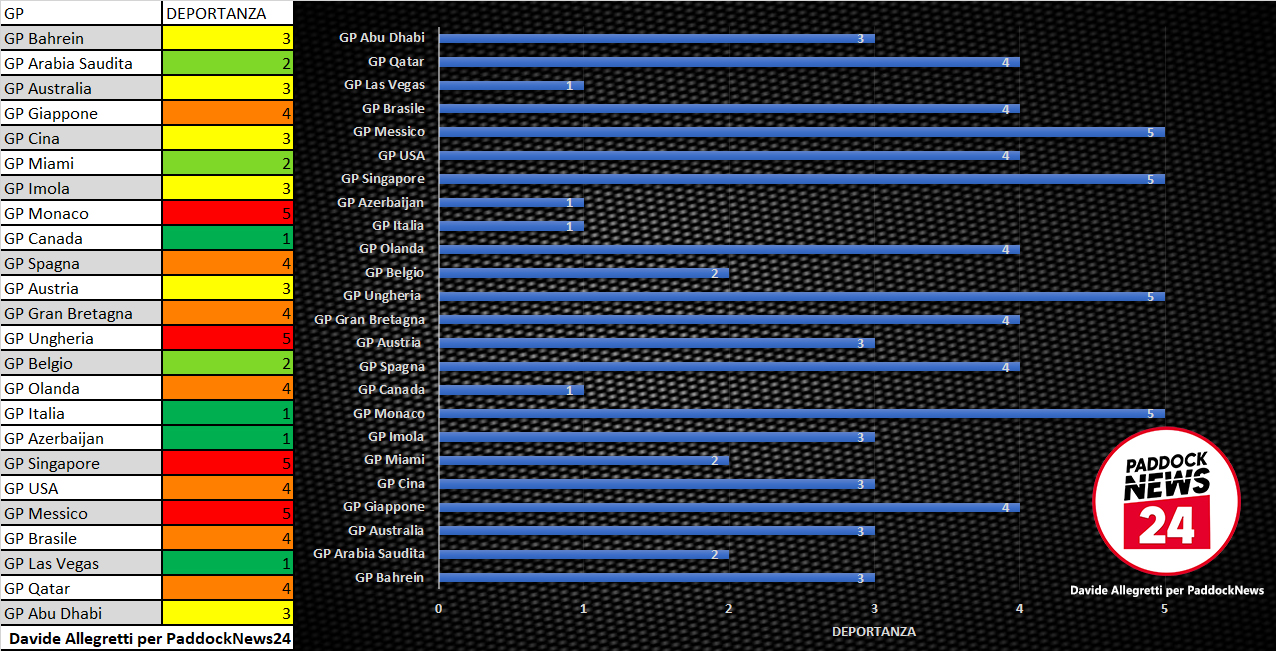All through our analyses, we now have usually talked about “aerodynamic load,” “high-downforce circuits,” and “low-downforce circuits.” However what do these phrases imply? How can we differentiate between numerous monitor varieties? We’ll discover these questions on this article with the assistance of our graphics.
Beginning with the fundamentals: aerodynamic load
The 2024 F1 season has undoubtedly delivered thrilling moments for motorsport fanatics. There’s been loads of motion on monitor and several other drivers contending for victory. A contributing issue is that some automobiles tailored higher than others to particular tracks all through the season. This often led to single-seaters displaying utterly completely different behaviors from one GP to the subsequent.
However why does this occur? Basically, two components are concerned. On one hand, it’s concerning the capacity of the automobiles to “digest” sure monitor traits. On the opposite, it’s concerning the tracks themselves.
Let’s begin with the automobiles. In idea, they need to be capable to carry out optimally on any sort of monitor. Nonetheless, this isn’t easy. For that reason, updates are launched to the automobiles through the season. The objective? To seek out the precise compromise for a particular monitor between downforce (often known as “aerodynamic load”) and drag (resistance to ahead movement). Due to this fact, it’s essential to grasp the distinction between downforce and drag. The picture beneath reveals how these two forces act. It’s evident that the load is primarily generated by the automobile’s flooring in fashionable autos. That is complemented by the load generated by the wings and the general automobile physique.
Downforce refers back to the power created by the airflow hitting the automobile, urgent it downward, and conserving it glued to the bottom. Greater downforce interprets into higher grip and, consequently, greater cornering speeds. Nonetheless, elevated downforce additionally ends in better drag, which reduces prime velocity. Because of this, the facility unit must ship extra energy. Primarily based on these ideas, tracks are categorized as “high-downforce circuits” and “low-downforce circuits.”
Excessive-downforce circuits: the right way to acknowledge them
The time period “high-downforce circuit” sometimes refers to tracks the place the prevalence of corners outweighs that of straights (a excessive variety of corners and few straights). On this case, the automobile’s downforce is extra essential than the engine’s energy. Due to this fact, in high-downforce circuits, a good portion of a automobile’s efficiency comes from the downforce it generates fairly than engine energy. Nonetheless, it’s not correct to say that energy has no impression on efficiency. The truth is, greater energy permits groups to go for extra aggressive setups and obtain optimum efficiency. On these tracks, groups use rear wings with greater incidence angles to realize better downforce and grip in corners. Widespread examples of high-downforce circuits embody Monaco, Singapore, Mexico, Hungary, and Brazil.
Low-downforce circuits: the right way to acknowledge them
The time period “low-downforce circuit” or “energy circuit” sometimes refers to tracks the place the prevalence of straights outweighs that of corners (lengthy straights and brief, sluggish corners). On this case, engine energy is extra essential than downforce. For these tracks, a good portion of efficiency comes from engine energy fairly than downforce. Nonetheless, it’s incorrect to say that downforce is pointless on low-downforce circuits. Monza is the quintessential energy circuit. It’s estimated that 75% of a lap right here is accomplished with the throttle absolutely open. For this house race, groups convey excessive automobile setups that received’t be used once more through the season. On this case, rear wings have minimal incidence angles to realize greater prime speeds and decrease drag. Widespread examples of low-downforce circuits embody Miami, Azerbaijan, Canada, and Belgium.
Identical monitor, differing types: it’s doable
Sure, it’s doable. Throughout the identical monitor, it’s doable to determine each high-downforce and low-downforce sectors. Examples embody Silverstone, Spa, and Austin. Micro-sector analyses have proven that automobiles carry out higher in sure sections of the monitor than others. As an illustration, McLaren has usually appeared extra aggressive in high-downforce sectors. For that reason, the automobile’s setup is decided by discovering the precise compromise between downforce and prime velocity. Moreover, different track-specific components, resembling monitor evolution, grip, and asphalt abrasion, play a task.
To conclude, we current beneath a abstract desk of the F1 2024 season circuits with their downforce ranges (Pirelli knowledge).

F1 2024 Downforce Circuits – Credit: Davide Allegretti for PaddockNews
Supply: paddocknews24



